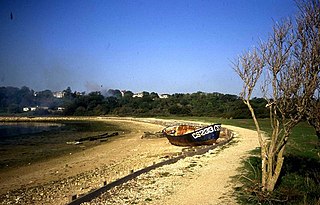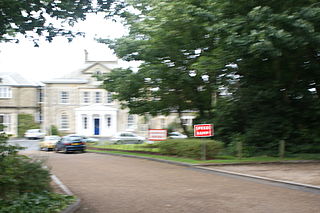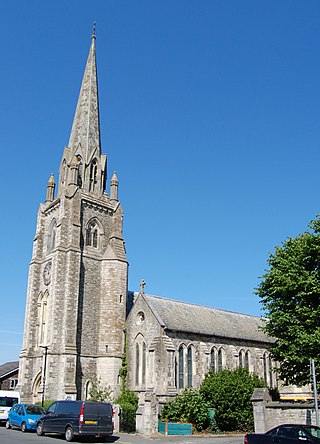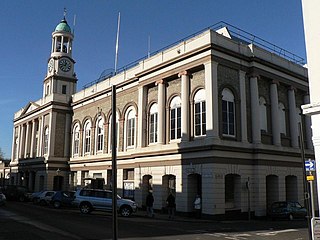
Wallsend is a town in North Tyneside, Tyne and Wear, England, at the eastern end of Hadrian's Wall. It has a population of 43,842 and lies 4 miles east of Newcastle upon Tyne.

Ryde is an English seaside town and civil parish on the north-east coast of the Isle of Wight. The built-up area had a population of 24,096 according to the 2021 Census. Its growth as a seaside resort came after the villages of Upper Ryde and Lower Ryde were merged in the 19th century, as can still be seen in the town's central and seafront architecture. The resort's expansive sands are revealed at low tide. Their width means the regular ferry service to the mainland requires a long listed pier – the fourth longest in the United Kingdom, and the oldest surviving.

The ancient 'Kynges Towne' of Brading is the main town of the civil parish of the same name. The ecclesiastical parish of Brading used to cover about a tenth of the Isle of Wight. The civil parish now includes the town itself and Adgestone, Morton, Nunwell and other outlying areas between Ryde, St Helens, Bembridge, Sandown and Arreton. Alverstone was transferred to the Newchurch parish some thirty years ago.

The Isle of Wight Council, known until 1995 as Isle of Wight County Council, is the unitary authority which governs the county of the Isle of Wight in South East England. The council is controlled by the Alliance Group, a coalition of Independent, Green, Independent Network, and Our Island councillors. Its headquarters is County Hall in Newport.

A duver is an Isle of Wight dialect term for a low-lying piece of land along the coast, subject to occasional inundation by the sea.

Southern Vectis is a bus operator on the Isle of Wight. The company was founded in 1921 as "Dodson and Campbell" and became the "Vectis Bus Company" in 1923. The company was purchased by the Southern Railway before being nationalised in 1969. In 1987, the company was re-privatised. In July 2005, it became a subsidiary of Go-Ahead Group.

Seaview is a small Edwardian resort located on the north-eastern corner of the Isle of Wight, overlooking the Solent. The village is popular with tourists and is 2+1⁄3 miles (3.8 km) from the town of Ryde, where most tourists reach the island by ferry or hovercraft. Together with Nettlestone, it forms a civil parish of Nettlestone and Seaview.

Nettlestone is a village on the Isle of Wight, England about 4 miles (6 km) south east from Ryde. It is listed in the Domesday Book and was established c.1086. Together with Seaview, it forms the civil parish of Nettlestone and Seaview.

Barton is an area in the east of Newport on the Isle of Wight. Transport is provided by Southern Vectis community service route 39 to the town centre and standard service routes 8 and 9 to Sandown and Ryde, which run close by.

Ryde School with Upper Chine is a co-educational independent day and boarding school in Ryde, on the Isle of Wight. The school, founded in 1921, is a member of the HMC.

Holy Trinity Church is a former Church of England parish church located in the town of Ryde on the Isle of Wight. Opened in 1845, consecrated the following year and parished in 1863, it became the rapidly growing town's first parish church. A "fine, gracious" and "imposing" structure with a 134-foot (41 m) spire, it is visible for miles as a landmark at the northern end of the island, along with nearby All Saints' Church. The building has been used as a community centre since it closed for worship in 2014. Historic England has listed it at Grade II for its architectural and historical importance.


Seaview Chain Pier was built in 1881 at Seaview, near Ryde on the Isle of Wight. The pier was designed by Frank Caws. Construction was from September 1879. The pier was opened in 1881 with finishing work completed in 1882. It was 1,000 foot (300 m) long and had a width of 15 foot (4.6 m). In 1889 the pier was extended to a length of 1,050 foot (320 m) as the result of work to better the landing stage. Traffic was disappointing and in 1901 the pier head was extended at a cost of £505 and amusements were added. Nevertheless 1900 was the last year in which the pier company managed to pay a dividend. In an attempt to improve matters the Seaview steam packet company was formed and began running a service between Seaview Chain Pier and South Parade Pier.

Thomas Hellyer was an English architect of the mid-Victorian era. He was based on the Isle of Wight and was "the leading Island-based architect of the period". His works can also be found on the mainland—principally in Hampshire, but also further afield. Described by Pevsner as a "very individualistic" and "remarkable" architect, his output included churches, houses, schools and hospitals across the island, built during a period of rapid urban development. Many of his buildings have listed status and he "made important contributions to the appearance of the city" of Portsmouth through his extensive work in the area.
Stephen Salter was an English architect who practised in Oxford, Maidenhead, and the Isle of Wight.

Ryde Town Hall is a municipal structure in Lind Street in Ryde, Isle of Wight, England. The town hall, which was the headquarters of Ryde Borough Council, is a Grade II listed building.
















